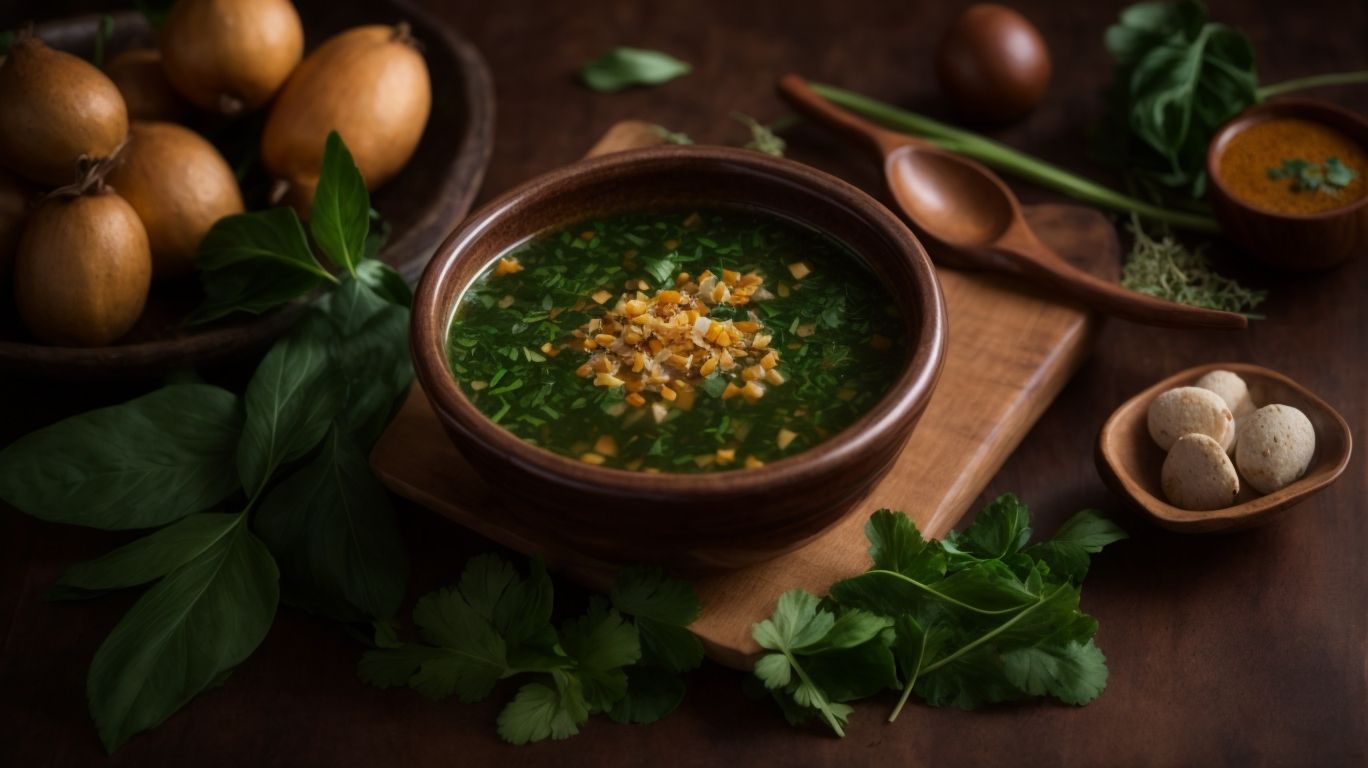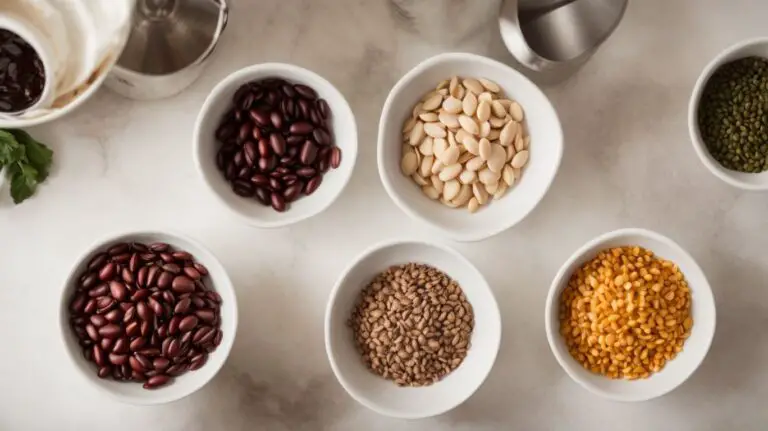How to Cook Ogbono Soup With Uziza Leaf?
Ready to take your taste buds on a culinary journey with Ogbono Soup and Uziza Leaf?
Discover the rich flavors and incredible health benefits of these traditional Nigerian ingredients.
Learn what Ogbono Soup and Uziza Leaf are, the main and optional ingredients needed, and follow our guide through each step of the cooking process.
Get expert tips and tricks on how to adjust the thickness of your Ogbono Soup with Uziza Leaf, store leftovers, and reheat for maximum flavor. Let’s get cooking!
Key Takeaways:
About Ogbono Soup and Uziza Leaf
Ogbono Soup and Uziza Leaf are traditional Nigerian dishes that offer a delightful blend of flavors and textures, perfect for family gatherings and special occasions.
These dishes hold a significant place in Nigerian culinary heritage, reflecting the country’s diverse culture and rich food traditions. Ogbono Soup, made from ground ogbono seeds, palm oil, and assorted meats or fish, exudes a distinct earthy taste and thick, mucilaginous texture.
On the other hand, Uziza Leaf adds a unique aromatic flavor with a slight peppery undertone to dishes, elevating the overall taste profile. To prepare Ogbono Soup, the ground seeds are combined with stock, vegetables, and seasonings while simmering over low heat to achieve a hearty consistency.
Meanwhile, the Uziza Leaf is typically added towards the end of cooking to preserve its flavors and ensure a vibrant green color. Its versatility allows it to be used in soups, stews, and traditional dishes, enhancing the overall culinary experience.
What Is Ogbono Soup?
Ogbono Soup is a traditional Nigerian dish made with ground Ogbono seeds, assorted meats, crayfish, and palm oil, known for its rich flavor and thick, viscous texture.
This flavorful concoction is a staple in Nigerian households, often served with fufu or pounded yam, creating a harmonious blend of textures and tastes.
- Ogbono seeds are the star ingredient, lending a unique nutty flavor and acting as a natural thickening agent when combined with palm oil.
- The use of assorted meats such as beef, goat, or fish adds depth to the dish, while crayfish contributes a distinct umami element.
What Is Uziza Leaf?
Uziza Leaf is a versatile ingredient used in Nigerian cooking, known for its aromatic flavor and medicinal properties, often paired with bitter leaf, seasoning cubes, and stockfish for enhanced taste.
With its distinct peppery taste, Uziza Leaf adds a unique kick to traditional dishes like Egusi soup and Ofe Nsala. Known for its antimicrobial properties, Uziza Leaf is a powerhouse of vitamins and minerals, aiding digestion and boosting immunity. It pairs incredibly well with the bitterness of bitter leaf, creating a balanced flavor profile that is further accentuated by the umami richness of seasoning cubes and the meaty depth of stockfish.
Ingredients for Ogbono Soup with Uziza Leaf
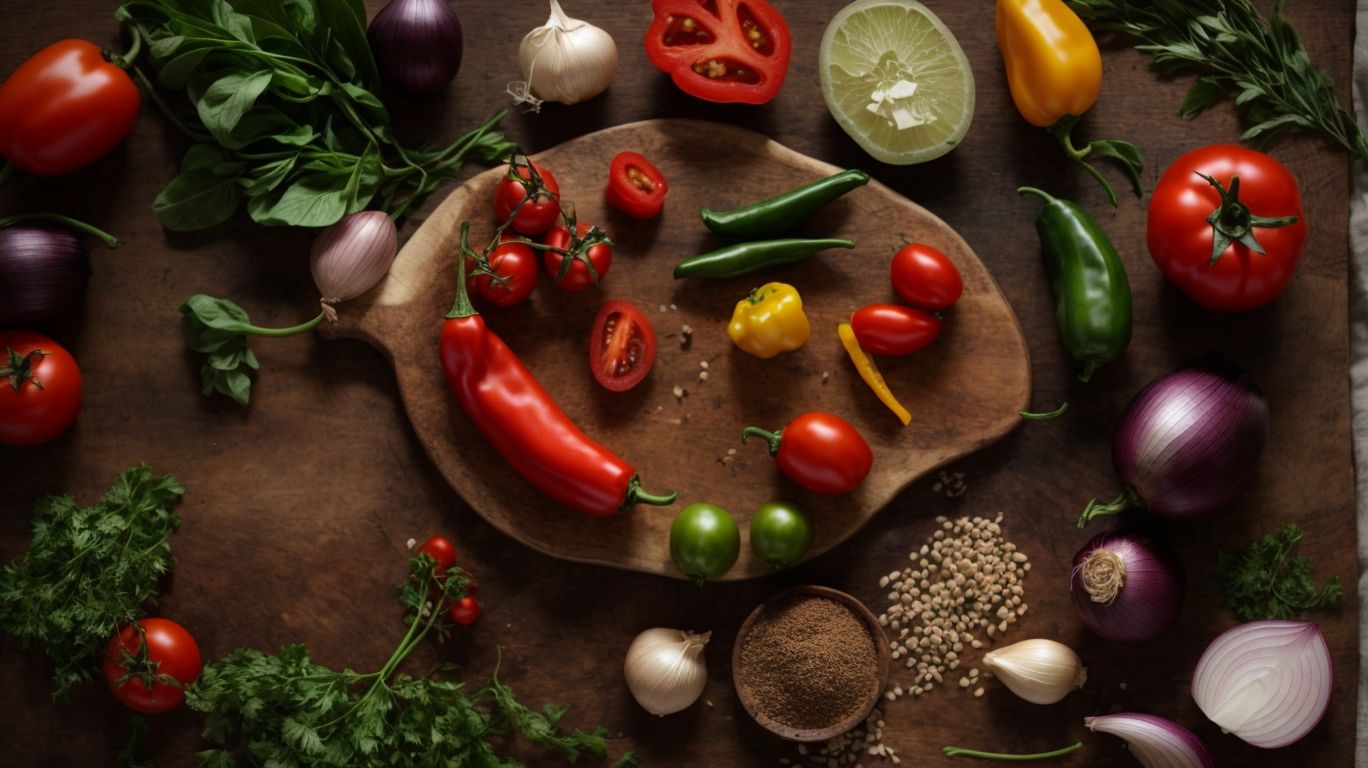
Credits: Poormet.Com – Jason Baker
To prepare Ogbono Soup with Uziza Leaf, gather the main ingredients such as Ogbono seeds, assorted meats, and Uziza leaves, along with optional additions like Pomo, crayfish, and seasoning cubes for added depth of flavor.
When making Ogbono Soup with Uziza Leaf, the Ogbono seeds play a crucial role in thickening the soup and giving it a unique, nutty flavor. The assorted meats, which can include beef, tripe, and cow feet, bring a rich savory taste and satisfying texture to the dish. Uziza leaves, with their aromatic and slightly peppery notes, add a refreshing twist.
Optional ingredients like Pomo, a type of cow skin, introduce a chewy element, while crayfish contributes a rich umami taste that enhances the overall complexity of the soup. Seasoning cubes, with their blend of spices and herbs, boost the flavors and tie all the ingredients together harmoniously.
What Are the Main Ingredients?
The main ingredients for Ogbono Soup with Uziza Leaf include Ogbono seeds, assorted meats, stockfish, and Uziza leaves, essential components that define the dish’s distinctive taste and texture.
In terms of Ogbono Soup, the choice of meat plays a crucial role in the overall flavor. Whether it’s beef, goat meat, or chicken, the meat adds depth and richness to the broth, infusing it with savory notes.
Stockfish, on the other hand, contributes a unique umami flavor and brings a satisfying chewiness to the dish. Its presence enhances the complexity of the soup, creating a well-balanced culinary experience.
Uziza leaves, known for their peppery aroma and slightly bitter taste, provide a distinctive twist to the soup. Rich in essential nutrients like vitamins A and C, these leaves not only enhance the flavor profile but also offer valuable health benefits.
What Are the Optional Ingredients?
Optional ingredients for Ogbono Soup with Uziza Leaf may include Pomo, crayfish, and seasoning cubes, offering additional layers of flavor and complexity to the traditional recipe.
Adding Pomo, a type of meat obtained from the skin of a cow, brings a chewy texture and rich taste to the soup, elevating its overall heartiness.
The inclusion of crayfish contributes a distinctive seafood undertone and enhances the umami essence of the dish, creating a harmonious depth of flavors.
Seasoning cubes play a crucial role in personalizing the soup, allowing individuals to adjust the saltiness and spice levels according to their own preference, thereby making the recipe adaptable to various taste preferences.
Steps to Cook Ogbono Soup with Uziza Leaf
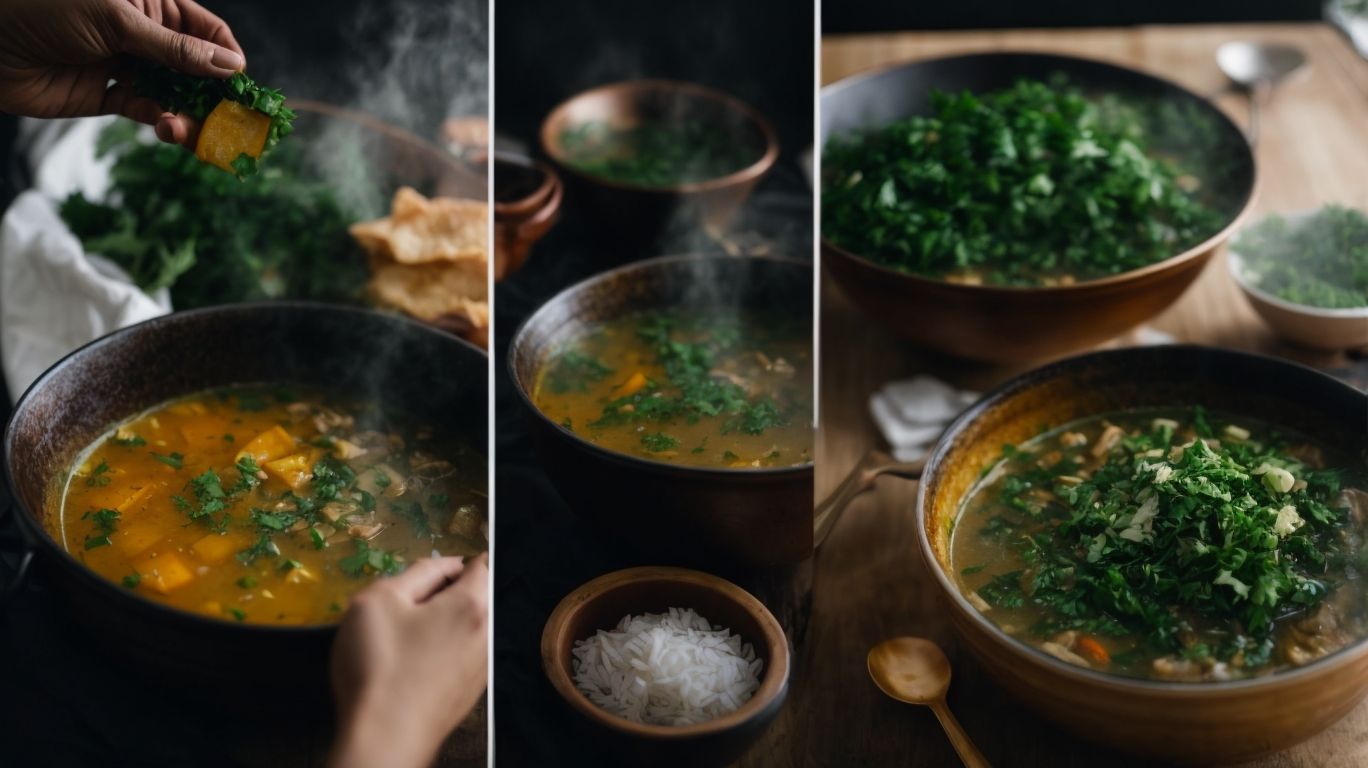
Credits: Poormet.Com – Michael Wright
To prepare a delicious batch of Ogbono Soup with Uziza Leaf, follow these simple and flavorful steps that guarantee a satisfying culinary experience for you and your loved ones.
Gather all the necessary ingredients including ground Ogbono seeds, palm oil, meats or fish of your choice, Uziza leaves, onions, crayfish, and stockfish.
- Next, heat the palm oil in a large pot, add chopped onions, and allow them to sauté until translucent. Then add the ground Ogbono seeds, stirring continuously to prevent lumps from forming.
After that, incorporate your choice of protein and stockfish, allowing them to simmer until they are partially cooked. Once the meats and fish are slightly tender, add water and allow the mixture to boil.
Add the Uziza leaves and crayfish to the pot, seasoning with salt and any additional spices for an extra burst of flavor. Let the soup simmer for a few more minutes before serving hot with a side of swallow or rice. Enjoy the rich and aromatic flavors of this traditional Nigerian dish!
Step 1: Prepare the Ingredients
Begin by gathering and preparing the essential ingredients for Ogbono Soup with Uziza Leaf, ensuring that the Ogbono seeds, assorted meats, and Uziza leaves are washed, chopped, and ready for use.
Proper handling of the ingredients sets the foundation for a delicious Ogbono Soup. To start, make sure to wash the Ogbono seeds thoroughly to remove any impurities. Once clean, carefully chop the assorted meats into bite-sized pieces for even cooking. Next, gently wash the Uziza leaves, ensuring they are free from dirt and debris.
Organize the ingredients neatly on your kitchen counter, ready to be incorporated into the flavorful broth. By taking these meticulous measures, you pave the way for a savory and satisfying dish that captures the essence of traditional Nigerian cuisine.
Step 2: Heat the Oil and Add the Onions
Heat a generous amount of palm oil in a pot and sauté the onions until translucent to create a flavorful base for the Ogbono Soup with Uziza Leaf, infusing the dish with aromatic undertones.
Once the palm oil begins to shimmer in the pot, carefully add the diced onions and let them cook over medium heat. Sautéing the onions not only softens them but also unlocks their natural sweetness, intensifying the depth of flavor in the soup.
As the onions turn golden brown and release their savory aroma, they lay the foundation of umami richness that will permeate the entire dish. The sizzling sound as they caramelize signifies the development of complex flavors, crucial for a well-balanced and satisfying Ogbono Soup.
Step 3: Add the Meat and Stock
Introduce the assorted meats and stock to the pot, allowing them to simmer and infuse the broth with rich flavors and tender textures, creating a hearty base for the Ogbono Soup with Uziza Leaf.
When selecting the meats for this soup, popular choices include chunks of beef shank, goat meat, and tripe for a diverse blend of textures and flavors. Each meat brings its unique taste profile to the dish, enriching the overall culinary experience. As the meats slowly simmer in the stock, their juices meld together, enhancing the savory essence of the broth.
The simmering process is crucial as it allows the meats to tenderize, ensuring they are soft and succulent when the soup is served. This slow cooking method also extracts flavors from the bones, adding depth to the broth. The simmering action helps amalgamate the different meat flavors, resulting in a cohesive and delicious final product.
Step 4: Add the Ground Ogbono Seeds
Gradually incorporate the ground Ogbono seeds into the simmering broth, stirring gently to ensure even distribution and proper thickening, resulting in a luscious and hearty texture for the Ogbono Soup with Uziza Leaf.
As the Ogbono seeds blend into the savory broth, their unique mucilaginous properties start to work their magic, transforming the liquid into a luxurious, velvety masterpiece. The seeds act as a natural thickener, giving the soup that rich consistency that is characteristic of traditional Nigerian cuisine. Ensuring that the seeds are evenly dispersed is crucial to prevent clumping and to allow for optimal flavor absorption. This meticulous process ensures that every spoonful of the Ogbono Soup is a delightful experience of flavors and textures.
Step 5: Add the Uziza Leaf and Other Optional Ingredients
Incorporate the Uziza leaves and any optional ingredients such as Pomo and seasoning cubes into the pot, allowing them to simmer and infuse the soup with vibrant flavors and aromatic notes, enhancing the overall taste profile of the dish.
Uziza leaves, with their distinct peppery flavor, add a unique dimension to the soup, creating a delightful contrast to the rich and nutty ogbono base. As the ingredients simmer together, their essences intertwine, producing a symphony of tastes that tantalizes the palate.
The addition of Pomo, a type of cow skin, brings a textural element to the dish, providing a satisfying chewiness that complements the smooth consistency of the soup. Meanwhile, seasoning cubes act as flavor enhancers, intensifying the savory notes and tying all the ingredients together harmoniously.
Step 6: Simmer and Serve
Allow the Ogbono Soup with Uziza Leaf to simmer gently, ensuring that the flavors meld together harmoniously before serving the dish piping hot, accompanied by a side of fluffy fufu or steamed rice for a complete and satisfying meal.
Once the soup has simmered to perfection, it’s time for the final touches to elevate the presentation. A sprinkle of freshly chopped Uziza leaves on top not only adds a pop of vibrant color but also enhances the aroma with its peppery notes. Carefully ladle the rich, viscous soup into elegant bowls, ensuring each serving is generous and visually appealing. For a finishing touch, serve the dish alongside warm fufu or a bed of fluffy rice, allowing the diners to savor the hearty flavors and textures of the dish.
Tips and Tricks for Cooking Ogbono Soup with Uziza Leaf
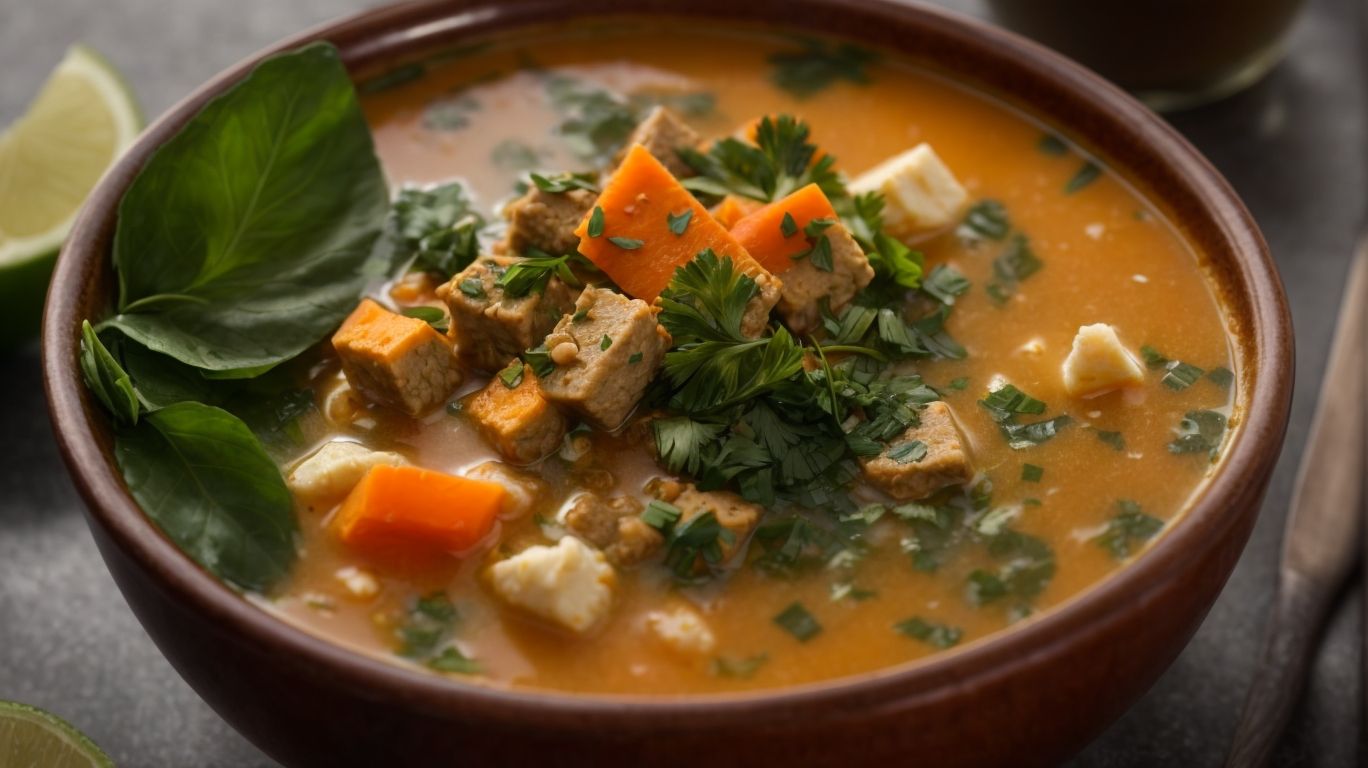
Credits: Poormet.Com – Matthew Taylor
Master the art of cooking Ogbono Soup with Uziza Leaf with these invaluable tips and tricks that guarantee a perfect consistency, flavor balance, and storage solutions for your culinary creations.
In terms of achieving the perfect consistency of Ogbono Soup, consider adjusting the amount of ground Ogbono seeds you use to match your preferred thickness. The key is to gradually add the ground Ogbono while stirring continuously to avoid clumps and ensure a smooth texture.
To enhance the flavor profiles of your Ogbono Soup, experiment with different seasoning combinations such as crayfish, stockfish, and smoked fish. These ingredients not only add depth to the flavor but also complement the earthy taste of Uziza Leaf.
Proper storage practices are essential to maintain the freshness of your soup. Store leftover Ogbono Soup in airtight containers in the refrigerator and consume within 2-3 days for optimal taste and quality.
How to Make the Soup Thicker or Thinner?
Adjust the consistency of your Ogbono Soup with Uziza Leaf by adding more ground Ogbono seeds for a thicker texture or diluting the soup with broth or water for a lighter, more liquid consistency, tailoring the dish to your preferences.
Thickening your Ogbono Soup can be achieved by first creating a roux with palm oil and ground Ogbono seeds before adding it gradually to the simmering broth. This method allows the soup to thicken naturally without clumping. On the flip side, if you prefer a thinner consistency, consider adding additional liquid components like more broth or water while adjusting the seasoning to maintain the flavor balance.
Experimenting with the amount of Uziza Leaf can also impact the texture of the soup. The leaves can provide additional thickness when finely chopped and added in generous amounts, enhancing both the flavor profile and mouthfeel of the dish. Remember, when it comes to Ogbono Soup, finding the right balance of ingredients is crucial to achieving the perfect consistency that suits your taste preferences.
How to Store Leftover Soup?
Store any leftover Ogbono Soup with Uziza Leaf in airtight containers and refrigerate promptly to maintain freshness and prevent spoilage, ensuring that the flavors remain intact for future enjoyment.
When storing your Ogbono Soup with Uziza Leaf, it is crucial to follow proper food storage practices to extend its shelf life. Refrigeration helps slow down bacterial growth and maintain the texture and taste of the soup. Opt for airtight containers to seal in the flavors and prevent any odors from the fridge affecting the soup’s taste.
Label the containers with the date to keep track of freshness and ensure you consume the soup within a safe timeframe. Avoid leaving the soup at room temperature for extended periods, as this can lead to spoilage and potential health risks.
How to Reheat the Soup?
Reheat your Ogbono Soup with Uziza Leaf gently on the stovetop or in the microwave, stirring occasionally to ensure even warming and preserve the dish’s original taste and texture, ready to be enjoyed as a comforting meal or snack.
When reheating your Ogbono Soup with Uziza Leaf, remember to use a low to medium heat setting to prevent burning and maintain the flavors.
- On the stovetop, place the soup in a saucepan over gentle heat.
- For microwave reheating, use a microwave-safe bowl and cover it with a microwave-safe lid or paper towel to prevent splatters.
Stirring periodically is crucial to distribute the heat evenly and prevent any parts of the soup from becoming too hot.
Consider adding a splash of water or broth to the soup before reheating to help retain moisture and prevent it from drying out. This simple trick can make a significant difference in the final taste and consistency of the dish.
Enjoy your reheated Ogbono Soup with Uziza Leaf, savoring the rich flavors and aromas with each delicious spoonful.
Frequently Asked Questions
Question: What are the ingredients needed to cook Ogbono Soup with Uziza Leaf?
To make Ogbono Soup with Uziza Leaf, you will need the following ingredients: 1 cup of dried Ogbono seeds, 1/2 pound of assorted meat (beef, cow feet, tripe), 1/2 pound of smoked fish, 1/2 cup of palm oil, 2 tablespoons of ground crayfish, 2 tablespoons of ground uziza leaves, 1 medium onion (chopped), 2-3 scotch bonnet peppers (chopped), salt, and seasoning cubes.
Question: How do I prepare the Ogbono seeds for cooking?
To prepare the Ogbono seeds, you will need to roast them in a pan until they turn a slightly darker shade of brown. Then, grind the seeds into a smooth powder using a blender or food processor. This process helps to release the natural oils in the seeds, which gives the soup its thick and smooth consistency.
Question: Can I substitute Uziza leaves with any other type of leaf?
Yes, you can substitute Uziza leaves with spinach, bitter leaf, or pumpkin leaves. However, keep in mind that the flavor and texture of the soup may vary slightly depending on the type of leaf used.
Question: How do I prevent lumps from forming in my Ogbono Soup?
To prevent lumps from forming in your Ogbono Soup, make sure to add the ground Ogbono seeds gradually while stirring constantly. You can also mix the ground Ogbono with a small amount of water before adding it to the soup.
Question: How long should I cook the Ogbono Soup with Uziza Leaf?
The cooking time for Ogbono Soup with Uziza Leaf is typically 20-25 minutes. However, you can adjust the cooking time to your preference, depending on how thick or light you want the soup to be.
Question: Can I freeze Ogbono Soup with Uziza Leaf?
Yes, you can freeze Ogbono Soup with Uziza Leaf. Let the soup cool completely before storing it in an airtight container and freezing it. To reheat, thaw the soup in the refrigerator, then heat it up in a pot on the stove. Add a little water to adjust the consistency if needed.

